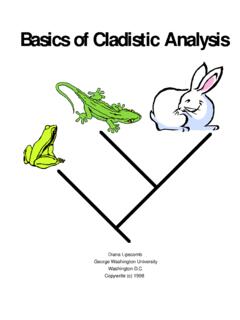Transcription of Creating Phylogenetic Trees with MEGA
1 Creating Phylogenetic Trees withMEGAPrat ThiruOutline MEGA Features Background on Phylogenetic Trees Brief Overview of tree Building Methods MEGA DemoMEGA Easy to use software with multiple features Features: Aligning sequences Estimating evolutionary distances Building Trees using several methods Testing tree reliability Marking Genes/Domains Testing for selection Computing sequence statisticsPhylogenetics Study of evolutionary relationship Phylogenetic tree is a graphical representation of the evolutionary relationships Phylogeny Species Strains Genes Metabolic Pathways Trees can be inferred by morphology or molecular informationWhy Create Phylogenetic Trees ? Reconstruct evolutionary history Draw conclusions of biological functions which might not be apparent Pre computed Trees (eg. Ensembl, Pfam) might not include genes or species of interestParts of a tree Nodes: taxonomic units (eg. genes, species, etc.) Internal: ancestral state Bifurcating Multifurcating External: Operational Taxonomic Units (OTUs) Branches: relationships among the taxonomic units (ie.)
2 Ancestor descendent relationship). Clade Branch Length: number of changes that have occurred Topology: branching pattern Rooted vs Unrooted treeOperational Taxonomic Unit (OTU)(Internal) NodeSteps to Create Phylogenetic Trees Identify and acquire the sequences that are to be included on the tree Align the sequences (MSA using ClustalW, T Coffee, MUSCLE, etc.) Estimate the tree by one of several methods Draw the tree and present itFrom Hall, ( see Further Reading Slide) tree Building MethodsCharacter State MatrixSpecies A ACTTCS pecies B AGTTCS pecies C CGTACS pecies D CCTACD istance MatrixA B C DA 1 B 1 1 1 Distance basedCharacter based Parsimony ProbabilisticExample:Distance based Unweighted Pair Group Method with Arithmetic mean (UPGMA) Neighbor Joining (NJ) Start with all taxa in a single node and decomposewith each iteration Pair of nodes pulled out (grouped) at each iteration are chosen so that the total length of the branches on the tree is minimized Mutation rates are not based.
3 Parsimony Preferred Phylogenetic tree is the one with the fewest evolutionary steps Identify informative sites For each possible tree , calculate the number of changes at each informative site Sum total number of changes for each possible tree , the tree with the smallest number of changes is selected as the most likely tree *informative siteCharacter based: Probabilistic Maximum Likelihood At each site, the likelihood is determined by evaluating the probability that a certain evolutionary model (eg. BLOSSUM or PAM matrices) has generated the observed data. The likelihood s for each site are then multiplied to provide likelihood for each tree Choose the tree with maximum likelihood Bayesian Inference Recent variant of ML Finds a set of Trees with the greatest likelihood given the dataComparison of Methods Distance based Results in a single tree UPGMA: reliable only for closely related species; replaced by NJ NJ: fast, suitable for large dataset Character based Multiple Trees will be found MP: long branch attraction problem ML: statistically well founded but slow for large dataset BI: faster to assess support for tree , prior distribution parameters must be specifiedHall, ( see Further Reading slide)Which Method to Use?
4 Accuracy looking at how closethe estimated tree is to the truetree resulted (in order of decreasing accuracy):Bayesian Inference Maximum Likelihood Maximum Parsimony Neighbor Joining Ease of Interpretation single vs multiple Trees Time and Convenience*Hall, ( see Further Reading slide)Data SetNeighbor JoiningMaximum ParsimonyMaximum LikelihoodBayesian InferenceSmall Data1 sec3 sec6 sec Small Data**9 sec10 min1 hr 34 min29 min 40 secLarge Data1 sec22 sec3 min 29 sec Large Data**86 sec10 hr 2 min58 hr6 hr 33 min* MacPro dual processor ( GHz); NJ and MP was using MEGA , ML by PHYML, and BI using MrBayes** with reliability estimateTree Reliability: Bootstrapping A statistical re sampling procedure commonly used for providing confidence to branches in Phylogenetic Trees A measure of repeatability, the probability that the branch would be recovered if the taxa were sampled again Bootstrapping values are typically presented from 1000 repeated calculations Bootstrap values of >70% is recommendedSome Tips Use more than one method Use more than one software package Examine more than one tree if multiple Trees are generated Bootstrap your data Homology vs Homoplasy Consider another intermediate taxa to resolve relationship, if neededPhylogenetic tree Software PHYLIP (the PHYL ogenyInference Package): PAUP*: MrBayes: MEGA(Molecular Evolutionary Genetic Analysis) More Comprehensive Listing of Phylogeny Programs: *Commercial softwareSummaryNature Reviews Genetics 4, 275 284 (2003)Further Reading Kumar, S.
5 , Dudley, J., Nei, M., and Tamura, K., MEGA: A biologist centric software for evolutionary analysis of DNA and protein in Bioinformatics 9: 299 306 (2008) Hulsenbeck, , and Ronquist, F., MyBayes: Bayesian inferences of 17:754 755 (2001) Holder, M., and Lewis, , Phylogeny estimation: traditional and Bayesian approaches. Nature Reviews Genetics4: 275 284 (2003)Books: Phylogenetic Trees Made Easy: A How to Manual 3rdEd. Hall, (2008) Inferring Phylogenies. Felsenstein, J. (2003)








